March is always an interesting month in the Carolina Piedmont--and not just because of college basketball's "March Madness." Historically, it's a month when we get surprisingly heavy snowfall . . . sometimes followed in short order by days of 80-degree weather. Here at Hilton Pond Center, this transitional time provides many contrasts and conflicts, as if nature can't quite decide whether it really is winter or spring. Several days this week, for example, there were ice crystals around the edge of Hilton Pond at dawn, Painted Turtles sunning on its banks by noon, and mating calls of Southern Leopard Frogs rising from the shallows as dusk settled in. Everywhere we looked plants and animals showed signs of growth or renewal, but some seemed hesitant lest they get knocked off in mid-March by a killing frost or devastating ice storm at the interface 'twixt winter and spring.
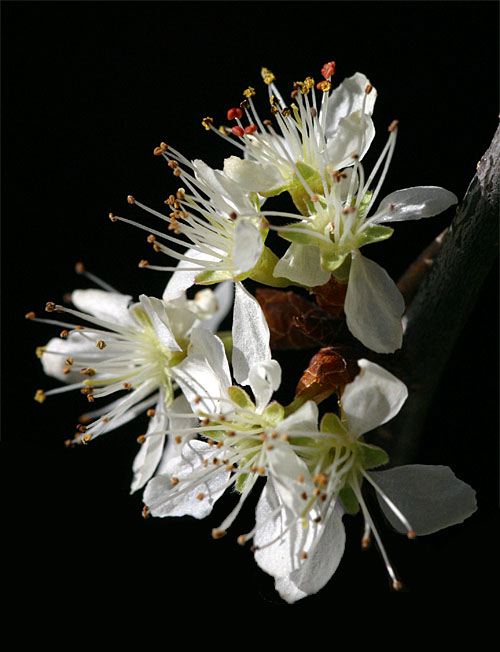
All text & photos © Hilton Pond Center
One plant getting a real head start was an early blooming wild plum, Prunus sp. (above), whose delicate white blossoms were already trying to attract pollinators so a new crop of plums could be made. Surprisingly, this is earlier by a week or so than our plum patch has ever bloomed. 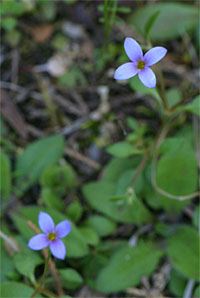 To be accurate, only ONE of the shrubs was in flower, and it was the one that basked in sunlight from about mid-morning to mid-afternoon; the others were growing in shade or received only dappled sunlight through what is still a leafless canopy. Perhaps their frigid flower buds have yet to be stimulated by the warmth of solar rays, or maybe this lone flowering plum was cheating a little and trying to get ahead of its neighbors in the annual race to spread its genes first and farthest. To be accurate, only ONE of the shrubs was in flower, and it was the one that basked in sunlight from about mid-morning to mid-afternoon; the others were growing in shade or received only dappled sunlight through what is still a leafless canopy. Perhaps their frigid flower buds have yet to be stimulated by the warmth of solar rays, or maybe this lone flowering plum was cheating a little and trying to get ahead of its neighbors in the annual race to spread its genes first and farthest.
At the base of the blooming plum was another early spring wildflower that might easily have been overlooked: The four-petalled Bluets or Quaker-lady, Houstonia sp. (above right), a tiny-quarter-inch blossom that grows in many yards across the eastern U.S. We'll see this little purplish-blue flower many times along the trails as spring unfolds at Hilton Pond Center, but it's always nice to spot the first one this early in March.
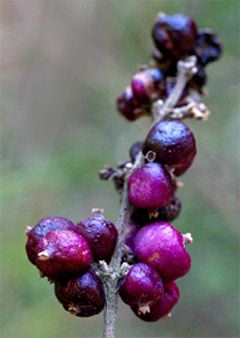 Just inside the edge of a small meadow near the Bluets we spotted a very different shade of purple, displayed by a wiry stalk of Coral-berry or Indian Currant, Symphoricarpos orbiculatus (left). This small deciduous native shrub--which grows wild from Upstate South Carolina northward to Connecticut and westward to Michigan and Colorado--is related to the invasive Japanese Honeysuckle vine, Lonicera japonica, but lacks the Asian import's bad habits. We've always been surprised that wildlife never seem to eat Coral-berry's purple fruit even by late winter; it seems odd that a plant would advertise its wares with such an obvious hue if animals don't consume it and disseminate its seeds in their droppings. Maybe the berry just tastes really bad. Just inside the edge of a small meadow near the Bluets we spotted a very different shade of purple, displayed by a wiry stalk of Coral-berry or Indian Currant, Symphoricarpos orbiculatus (left). This small deciduous native shrub--which grows wild from Upstate South Carolina northward to Connecticut and westward to Michigan and Colorado--is related to the invasive Japanese Honeysuckle vine, Lonicera japonica, but lacks the Asian import's bad habits. We've always been surprised that wildlife never seem to eat Coral-berry's purple fruit even by late winter; it seems odd that a plant would advertise its wares with such an obvious hue if animals don't consume it and disseminate its seeds in their droppings. Maybe the berry just tastes really bad.
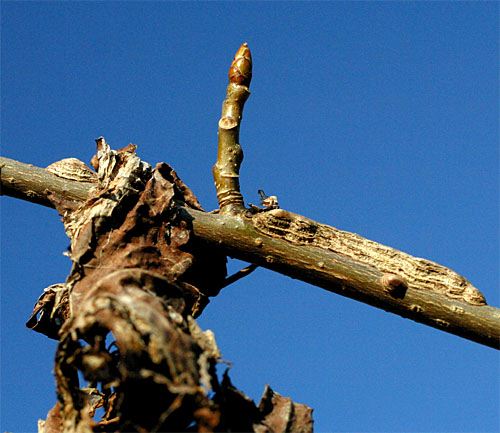
One sure sign that winter is waning and spring is on the way is the condition of terminal buds on many local trees and shrubs. Just as the flower buds on our wild plum have sprung open, so do the leaf buds of woody plants begin to swell as prelude to forming foliage. We found one Sweetgum, Liquidambar styraciflua, with part of its twig still wrapped in a dead leaf from last year (above), but with a side branch just waiting to open its terminal bud and expose this year's delicate green leaves. Below the bud were several oval scars where the previous year's leaf petioles were attached, and on the main twig were irregularly shaped corky growths that occur on many Sweetgums. These protuberances, some botanists suspect, increase the surface area of the twig and allow for more efficient gas exchange. This makes sense in Sweetgums, since their young twigs are greenish and may carry out limited photosynthesis before ageing and becoming covered by dead but protective brown bark.
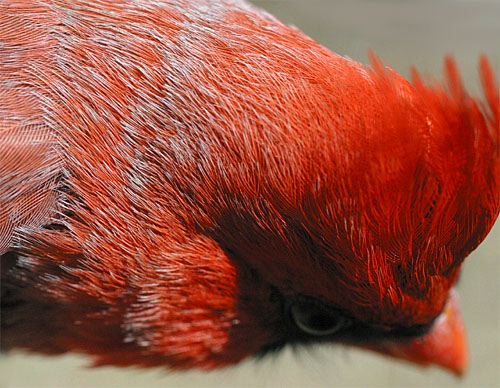
Signs of spring have also been obvious among birds at Hilton Pond Center. If we can judge by their plumage, our Northern Cardinals are about ready for the warm season to arrive. Last May the adult male cardinals were adorned in their brightest breeding colors--intense red on head and body with a rich black mask around the eyes and base of the bill. At summer's end these birds brought in a new set of feathers that were just as red, but it was hard to tell; the central portion of each feather was indeed bright red, but feather tips feathers were light grayish-brown (above). As the upcoming nesting season draws closer, the drab tips of the feathers wear off--perhaps due to intense pre-courtship preening by the male--to reveal the brilliant red beneath. This red, of course, serves to attract attention of the female, whose genes likely tell her that males with the most intense colors are the oldest, healthiest individuals and the best potential fathers for her future offspring. The grayish tips on a male's winter feathers may provide a slight degree of camouflage in the "off season" when breeding isn't possible; if nothing else those tips protect the brightest part of the male's red feather until the proper time to show it off.
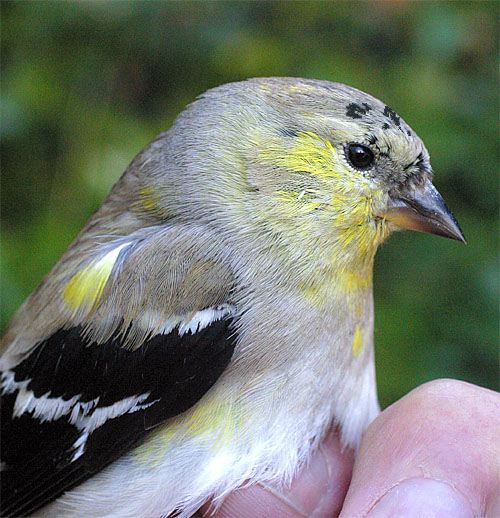
We've had a ton of American Goldfinches hanging around the Center's feeders all winter and they, too, show signs that breeding time isn't far away. During cold months, male and female goldfinches look pretty much alike, with dark wings against pale olive-gray bodies and heads. Females may color up a little in spring, but they look much the same year-round. Males, on the other hand, undergo significant transformation, bringing in bright canary-yellow feathers on the crown, back, and chest and gaining a jet-black forehead. This week at Hilton Pond some males are already showing their colors (above), but what makes them different from cardinals is that the goldfinch actually gets a whole new suit. 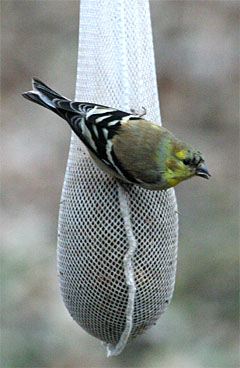 In other words, the feather tips don't wear off to reveal brighter colors beneath; instead, each feather is replaced. To our knowledge goldfinches are the only cardueline finches that follow this molt strategy--one that may be related to the goldfinch being the last birds to actually start nesting each year in the Carolina Piedmont. Often they don't breed until early or mid-summer, so it may be important for them to have a spring molt that produces the brightest plumage possible for a "delayed" breeding season. In other words, the feather tips don't wear off to reveal brighter colors beneath; instead, each feather is replaced. To our knowledge goldfinches are the only cardueline finches that follow this molt strategy--one that may be related to the goldfinch being the last birds to actually start nesting each year in the Carolina Piedmont. Often they don't breed until early or mid-summer, so it may be important for them to have a spring molt that produces the brightest plumage possible for a "delayed" breeding season.
And speaking of summer, the calendar says that season is still quite a ways off, but if we can judge from the flora and fauna at Hilton Pond Center, spring itself is just around the corner. Don't be surprised, however, if we get yet another March snowstorm during this strange period 'twixt winter and spring, and rest assured the partly molted calico goldfinches will continue to clamor for sunflower and thistle at your backyard feeder.
All text & photos © Hilton Pond Center
Comments or questions about this week's installment?
Please send an E-mail message to INFO.
NOTE: Be sure to scroll down for an account of all birds banded or recaptured during the week, as well as some other interesting nature notes.
"This Week at Hilton Pond" is written & photographed
by Bill Hilton Jr., executive director of
Hilton Pond Center for Piedmont Natural History.
You may wish to consult our Index of all nature topics covered since February 2000. You can also use the on-line Search Engine at the bottom of this page.
For a free, non-fattening, on-line subscription to "This Week at Hilton Pond," just send us an E-mail with SUBSCRIBE in the Subject line. Please be sure to configure your spam filter to accept E-mails from hiltonpond.org.
|


 To be accurate, only ONE of the shrubs was in flower, and it was the one that basked in sunlight from about mid-morning to mid-afternoon; the others were growing in shade or received only dappled sunlight through what is still a leafless canopy. Perhaps their frigid flower buds have yet to be stimulated by the warmth of solar rays, or maybe this lone flowering plum was cheating a little and trying to get ahead of its neighbors in the annual race to spread its genes first and farthest.
To be accurate, only ONE of the shrubs was in flower, and it was the one that basked in sunlight from about mid-morning to mid-afternoon; the others were growing in shade or received only dappled sunlight through what is still a leafless canopy. Perhaps their frigid flower buds have yet to be stimulated by the warmth of solar rays, or maybe this lone flowering plum was cheating a little and trying to get ahead of its neighbors in the annual race to spread its genes first and farthest. Just inside the edge of a small meadow near the Bluets we spotted a very different shade of purple, displayed by a wiry stalk of Coral-berry or Indian Currant, Symphoricarpos orbiculatus (left). This small deciduous native shrub--which grows wild from Upstate South Carolina northward to Connecticut and westward to Michigan and Colorado--is related to the invasive Japanese Honeysuckle vine, Lonicera japonica, but lacks the Asian import's bad habits. We've always been surprised that wildlife never seem to eat Coral-berry's purple fruit even by late winter; it seems odd that a plant would advertise its wares with such an obvious hue if animals don't consume it and disseminate its seeds in their droppings. Maybe the berry just tastes really bad.
Just inside the edge of a small meadow near the Bluets we spotted a very different shade of purple, displayed by a wiry stalk of Coral-berry or Indian Currant, Symphoricarpos orbiculatus (left). This small deciduous native shrub--which grows wild from Upstate South Carolina northward to Connecticut and westward to Michigan and Colorado--is related to the invasive Japanese Honeysuckle vine, Lonicera japonica, but lacks the Asian import's bad habits. We've always been surprised that wildlife never seem to eat Coral-berry's purple fruit even by late winter; it seems odd that a plant would advertise its wares with such an obvious hue if animals don't consume it and disseminate its seeds in their droppings. Maybe the berry just tastes really bad.


 In other words, the feather tips don't wear off to reveal brighter colors beneath; instead, each feather is replaced. To our knowledge goldfinches are the only cardueline finches that follow this molt strategy--one that may be related to the goldfinch being the last birds to actually start nesting each year in the Carolina Piedmont. Often they don't breed until early or mid-summer, so it may be important for them to have a spring molt that produces the brightest plumage possible for a "delayed" breeding season.
In other words, the feather tips don't wear off to reveal brighter colors beneath; instead, each feather is replaced. To our knowledge goldfinches are the only cardueline finches that follow this molt strategy--one that may be related to the goldfinch being the last birds to actually start nesting each year in the Carolina Piedmont. Often they don't breed until early or mid-summer, so it may be important for them to have a spring molt that produces the brightest plumage possible for a "delayed" breeding season.

 Oct 15 to Mar 15
Oct 15 to Mar 15
